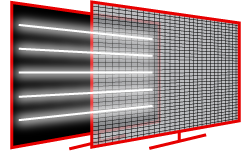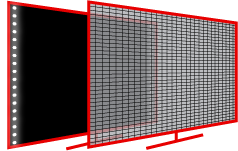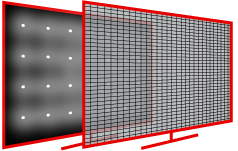So thought I'd make a thread that discusses several aspects of a new batch of technologies that we are starting to see in the current batch of TVs. What they are and why they might be important.
This is intended to be a layman's guide, so please excuse any minor inaccuracies, but feel free to comment on how something may be better explained. I've tried to keep colour spaces and software out of this (beyond dithering) intentionally.
How does an LCD work?
I'm not going to go into the finer details of optics and polarisation, but let's understand the basics.
a Liquid Crystal display is a laminate of transparent materials that when an electrical current is passed through it, it darkens, becoming black in appearnce and reducing the amount of light that light that can pass through.
fun-fact.The original Gameboy had a monochrome LCD that could switch each pixel between 4 levels of opacity. (2bit color)
Each pixel of a color LCD screen is made of 3 sub-pixels.

Each Sub pixel is a transparent cell that is either transparent red, transparent green, transparent blue.
Behind the LCD itself is a source of light, the Screen's backlight, this is providing the illumination that allows us to see more than just a black nothing.
Here is a close up of the sub pixels, when no opacity/voltage is being applied

Each one of these lttile stained glass windows have the blinds fully open, allowing all the light coming through to show off the color of the window.
Backlights
This used to be a Cold Cathrode Flueurescent lamp (CCFl) which is essence is some very thin flueorescent tube lighting (ala neon or strip lights) around the edge of the panel, or directly behind the LCD.

More modern TVs have replaced this tube based lighting with more energy efficient and less bulky LEDs, which is why newer LED LCD TVs are a lot thinner.. The LEDs for the most part are purely reffering to how the pixels are illuminated. A LED screen refers only to it's backlighting method.


Anyway, back to the pixels!
When a voltage is applied to each subpixel cell it becomes opaque, almost solid black, allowing very little light through. However, some light still passes through - It is really important to understand that when we start talking about other things later on.

8-Bit color
By carefully varying the voltage , each sub-pixel in an 8 bit panel can change between 256 different shades or states of opacity. From fully activated with the most voltage applied, to no voltage applied and the cell remaining transparent red,green or blue.
Using these combinations of 256 shades of Red, Green and Blue an LCD panel is able to display as many as 16,777,216 colours (256*256*256) and produce an image. This is called 8 bit color (or True color 24bit color)

10 bit color
In a native 10 bit panel, each sub-pixel can change between 1024 different shades. This greater control allows for more colours to be produced, filling in some of the missing colors that exist between the shades of 8 bit color. A 10 bit panel is natively capable of displaying 1,073,741,824 colors, this is also known as 30 bit color or Deep color.
Here is a very exaggerated image to represent a very exaggerated difference between using more and less colours.

When more colors are able to be rendered, color banding can be reduced and it brings us closer a totally natural image. It's function is not to make images appear more saturated or vivid or POP, but to produce an overall improvement in image quality, bringing what our displays can create, closer to what exists in the real world.
Dithering
Some Televisions attempt to bypass their native ability to display colours by using dithering to produce an image that perceptually looks close to being composed of a greater number of colours.
Here is an example of an 8 bit image made of almost the full 16.8 million colors and a dithered image that is produced using only 128 colours.

As you can see, at a distance the appearance is very close, but get nearer or look at it on a bigger screen and you can see how the image has been cheated. Again, a super exaggerated example to show what we are reffering to. Dithering is the color equivelant of upscaling. It can do a really good job of representing the same thing, but the native option is always going to be the better looking one.
In the past cheaper LCD panels could sometimes be 6 bit panels and use dithering to display the standard 8 bit colour that all content is made to, however in 2016, there are a batch of entry level 8bit TVs supporting the input of 10bit image sources via dithering.
Unfortunately for gamers with 8bit+Dithering panels ,dithering is an image processing technique, meaning you could lumbered with further input lag if this if your TV's default method of of dealing with a 10bit signal (perhaps from an HDR10 source)
As it stands as of writing this post, when it comes to gaming, there is very little evidence that any console games are using 10 bit assets or lighting. The Ps3 has been capable of 10 bit color since it was launched in 2006 , and both PS4 and Xbox One have had Deep Color/30bit color support since launch. So it has been a choice made by developers not to do this.
Part of the reason for it's non existence right now is that there is likely to be small performance penalties for using 10 bit assets and outputs in a game engine as it requires more bandwidth, much as using a higher resolution texture.
Also, consumer Televisions have only had native 10 bit output as of about 2015, which has meant that the number of people who would benefit has been very small, and from a production point of view it would also mean outfitting all workstations in a dev studio with 10 bit panels, which as of now only come in 2 flavors.
Super huge or super expensive.
Anyway, I hope this is informative for people who wanted to know a bit more, but also isn't too wrong.
I was originally going to include contrast ratio and HDR in this post, but I thought that might be better suited to a separate thread.
This is intended to be a layman's guide, so please excuse any minor inaccuracies, but feel free to comment on how something may be better explained. I've tried to keep colour spaces and software out of this (beyond dithering) intentionally.
How does an LCD work?
I'm not going to go into the finer details of optics and polarisation, but let's understand the basics.
a Liquid Crystal display is a laminate of transparent materials that when an electrical current is passed through it, it darkens, becoming black in appearnce and reducing the amount of light that light that can pass through.
fun-fact.The original Gameboy had a monochrome LCD that could switch each pixel between 4 levels of opacity. (2bit color)
Each pixel of a color LCD screen is made of 3 sub-pixels.

Each Sub pixel is a transparent cell that is either transparent red, transparent green, transparent blue.
Behind the LCD itself is a source of light, the Screen's backlight, this is providing the illumination that allows us to see more than just a black nothing.
Here is a close up of the sub pixels, when no opacity/voltage is being applied

Each one of these lttile stained glass windows have the blinds fully open, allowing all the light coming through to show off the color of the window.
Backlights
This used to be a Cold Cathrode Flueurescent lamp (CCFl) which is essence is some very thin flueorescent tube lighting (ala neon or strip lights) around the edge of the panel, or directly behind the LCD.

More modern TVs have replaced this tube based lighting with more energy efficient and less bulky LEDs, which is why newer LED LCD TVs are a lot thinner.. The LEDs for the most part are purely reffering to how the pixels are illuminated. A LED screen refers only to it's backlighting method.


Anyway, back to the pixels!
When a voltage is applied to each subpixel cell it becomes opaque, almost solid black, allowing very little light through. However, some light still passes through - It is really important to understand that when we start talking about other things later on.

8-Bit color
By carefully varying the voltage , each sub-pixel in an 8 bit panel can change between 256 different shades or states of opacity. From fully activated with the most voltage applied, to no voltage applied and the cell remaining transparent red,green or blue.
Using these combinations of 256 shades of Red, Green and Blue an LCD panel is able to display as many as 16,777,216 colours (256*256*256) and produce an image. This is called 8 bit color (or True color 24bit color)

10 bit color
In a native 10 bit panel, each sub-pixel can change between 1024 different shades. This greater control allows for more colours to be produced, filling in some of the missing colors that exist between the shades of 8 bit color. A 10 bit panel is natively capable of displaying 1,073,741,824 colors, this is also known as 30 bit color or Deep color.
Here is a very exaggerated image to represent a very exaggerated difference between using more and less colours.

When more colors are able to be rendered, color banding can be reduced and it brings us closer a totally natural image. It's function is not to make images appear more saturated or vivid or POP, but to produce an overall improvement in image quality, bringing what our displays can create, closer to what exists in the real world.
Dithering
Some Televisions attempt to bypass their native ability to display colours by using dithering to produce an image that perceptually looks close to being composed of a greater number of colours.
Here is an example of an 8 bit image made of almost the full 16.8 million colors and a dithered image that is produced using only 128 colours.

As you can see, at a distance the appearance is very close, but get nearer or look at it on a bigger screen and you can see how the image has been cheated. Again, a super exaggerated example to show what we are reffering to. Dithering is the color equivelant of upscaling. It can do a really good job of representing the same thing, but the native option is always going to be the better looking one.
In the past cheaper LCD panels could sometimes be 6 bit panels and use dithering to display the standard 8 bit colour that all content is made to, however in 2016, there are a batch of entry level 8bit TVs supporting the input of 10bit image sources via dithering.
Unfortunately for gamers with 8bit+Dithering panels ,dithering is an image processing technique, meaning you could lumbered with further input lag if this if your TV's default method of of dealing with a 10bit signal (perhaps from an HDR10 source)
As it stands as of writing this post, when it comes to gaming, there is very little evidence that any console games are using 10 bit assets or lighting. The Ps3 has been capable of 10 bit color since it was launched in 2006 , and both PS4 and Xbox One have had Deep Color/30bit color support since launch. So it has been a choice made by developers not to do this.
- Microsoft has stated that games are not being produced utilising 10 bit color or any sort of Wider Color Gamut (WCG).
- However UHD BluRays on Xbox One S are using 10bit color.
- Sony has made no comment or confirmation eiher way.
- No analysis or observations have been made that categorically support the notion that PS4 games are utilising 10 bit color.
Part of the reason for it's non existence right now is that there is likely to be small performance penalties for using 10 bit assets and outputs in a game engine as it requires more bandwidth, much as using a higher resolution texture.
Also, consumer Televisions have only had native 10 bit output as of about 2015, which has meant that the number of people who would benefit has been very small, and from a production point of view it would also mean outfitting all workstations in a dev studio with 10 bit panels, which as of now only come in 2 flavors.
Super huge or super expensive.
Anyway, I hope this is informative for people who wanted to know a bit more, but also isn't too wrong.
I was originally going to include contrast ratio and HDR in this post, but I thought that might be better suited to a separate thread.
